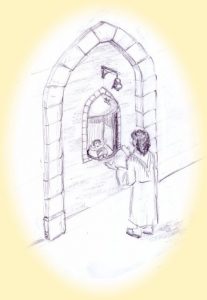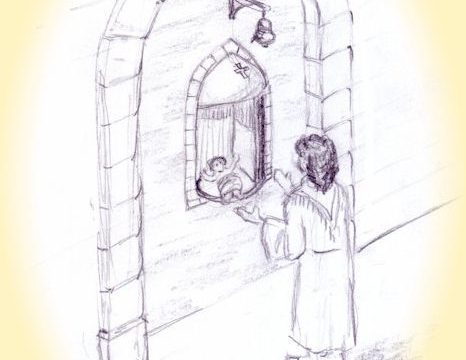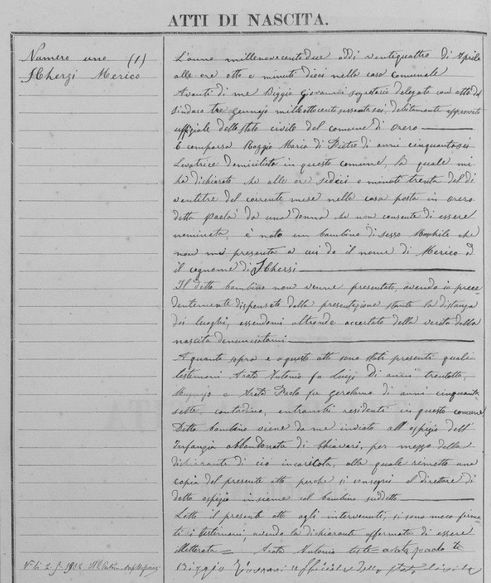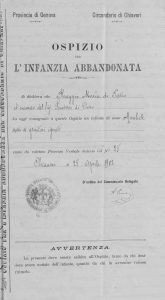From https://www.familysearch.org/wiki/en/Italian_Infant_Abandonment
Italian Infant Abandonment
Understanding the history of the Italian infant abandonment system and its name-assignment practices may help you understand how some of your ancestors acquired their surnames and possibly help you find and identify ancestors in the records.
Also see Foundlings Article for more info at http://www.conigliofamily.com/Foundlings.htm

History
From about the thirteenth century through the end of the nineteenth century, throughout the areas that in 1860 became unified Italy, a pregnant single woman, faced with the loss of her own and her family’s honor, would leave her residence to give birth elsewhere and after having the baby baptized, would give (or have the midwife give) the newborn baby to a foundling home (ospizio) to be cared for by others. For about a year after giving birth, the unwed mother, in order to pay for her own infant’s care, often served in the ospizio as a wet nurse for the children of others though almost never for her own child. (Kertzer, pp. 131-33, 162-63.) With few exceptions, she would have no contact with her child ever again.
Other new mothers anonymously abandoned their infants at the “wheel” (la ruota) located in the outside wall of the ospizio, sometimes leaving a sign of recognition (segno di riconoscimento), such as the image of a saint, a foreign coin, a torn piece of cloth, or other talisman, to preserve the mother’s ability, rarely exercised, of returning to reclaim the child, sometimes a year later or even many years later.
Meanwhile, the foundling homes attempted to place the babies with lactating women in foster families, typically in the countryside, though some of the children remained in an ospizio for up to five or ten years or even longer and in some cases for their entire lives. (Kertzer, pp. 85-6, 116.) Naples was an exception; due to lack of funding to pay external wet nurses, the foundling home there attempted to care for the bulk of its abandoned babies within the foundling home itself, without placement with outside wet nurses. (Kertzer & White, 1994, p. 454.) Large percentages of the abandoned infants did not survive infancy. Those who did survive entered a new life in a new place with a new family.
This system — which began in the areas that later became Italy and which spread to France, Belgium, Portugal, Spain, Ireland, Poland, and most of the Austrian provinces (Kertzer, p. 10) — was finally abandoned in Italy and elsewhere by about the beginning of the twentieth century. Some aspects of the system have re-emerged today in the “safe-haven laws” enacted recently in all 50 states and the District of Columbia within the United States (Guttmacher, p. 1) and in such other countries as Germany, Hungary, the Philippines, Slovakia, South Africa, Austria, Switzerland, Poland, Czech Republic, Latvia, India, Italy, and Pakistan, all of which strictly govern but to varying degrees permit some form of abandonment of newborns, all with the aim to help stem infanticide and make abortion rare. (Mueller & Scherr, p. 2.)
As conducted in Italy for about seven centuries, with varying degrees of success, the infant abandonment system was prompted by “great concern for the lives of women who found themselves in the desperate position of being pregnant and unmarried, with no one to care for their child.” (Kertzer, p. 37.)
Name-Assignment Practices
The Italian infant-abandonment system generally but not always included the assignment of a surname to the infant upon arrival at the ospizio. Thus while in the ospizio and later when placed with a family in the countryside, the child bore a surname different from its unknown family of origin and different from the family with which it was placed. (Kertzer, pp. 119-22.) “Until the nineteenth century, foundlings in many areas were baptized with first names only and were not given a last name.” (Kertzer, p. 119.)
But generally, upon arrival at the ospizio shortly after baptism, a new surname was assigned. And once the infant or child was placed with a wet nurse in the countryside, it would be assigned a surname used locally for foundlings (such as Della Casa or Casagrande or Esposito, as shown by a few examples in the table below). For the most part the new surname was used by the child throughout the remainder of its life, though often at the time of marriage or with the births of children to that marriage, the once-abandoned child, even a male child, might assume the surname of a spouse, passing that surname on to the children of the couple.
Samples of Surnames Assigned to Abandoned Infants
| Latin or Italian | Meaning in English |
| Della Casagrande | “Of the Ospizio” (of the Hospital or Hospice) |
| De Domo Magna | “Of the Ospizio” (of the Hospital or Hospice) |
| Innocenti | “Innocent One” |
| Della Scala | Name assigned by foundling home in Sienna |
| Projetti | Name assigned by foundling home in Rome |
| Esposito | “Abandoned” |
| Degli Esposti | “Abandoned” |
| Ospizio | Foundling Home |
| Incogniti | “Unknown” |
| Circoncisi | “Circumcised” |
| Palma | Surname given to child born or abandoned on Palm Sunday |
Thus, for example, if an abandoned child named Giuseppe were to have come from the ospizio to a local wet nurse to be taken in by a local family, the child might be raised with the “Casagrande” surname and, upon marriage to a woman maiden surnamed “Risso,” might thereafter in the records of births of their children be referred to as “Giuseppe Risso Casagrande” or “Giuseppe Risso della Casa Grande” or “Giuseppe Risso di Casa,” or the like. Sometimes the surnames assigned in the ospizi were used by the child throughout its life, with no new assignment in the residence location of the adopting family.
Such names were usually unique. In the Florence ospizio, sometimes an elaborate form of the first name was used for the new surname, such as by pluralizing the first name (Amato Amati, Barbera Barberi) or by abbreviating the first name (Serafino Serafi, Anselmo Selmi). In Milan, from 1475 to 1825, every foundling was given the surname Colombo (“pigeon”), still the second most common surname in Milan and the fifth most common surname in all of Italy. Because of the stigma often formerly attached to children of illegitimate birth, and the manner in which that stigma often was perpetuated by the assignment of surnames that signaled the child’s early history of abandonment, efforts sometimes were made to assign surnames that hid that history.
For example, in 1862 in Bologna, wet nurses were ordered to register the births of foundlings and provide them with both first and last names, but it was suggested that surnames be derived from words descriptive of things within one of the three kingdoms of nature (minerals, vegetables, and animals), such as Gessi (gypsum), Sassi (stones), Pietra (rock), Monti (mountains), Foblia (leaf), Rosa (rose), Garofonio (carnation), Colombi (pigeons), Leoni (lions). This practice spread through much of the northern part of Italy.
Parenthetically, the suname “Casagrande,” mentioned in a few examples above, means literally “large house” and is an apt description of the massive Ospedale di Pammatone in Genoa (1766-1942), a location where ever enlarging hospital structures were established between about 1422 and 1942 when the Pammatone was destroyed during the Second World War. It is where, for one example of thousands upon thousands, in about 1761 or 1762 a man named Francesco della Casa Grande was abandoned at the ruota of the ospedale and cared for as an abandoned infant before being placed in the municipality of Lumarzo, 27 km (17 mi.) to the east by north east of Genoa, where he would live until 1849 when he died there at 87 years of age. (Sign in and see his Lumarzo death certificate at https://familysearch.org/pal:/MM9.3.1/TH-1971-26956-14185-2.) Numerous images of the hospital, including paintings and photographs, both before and after its destruction, can easily be found by performing an image search on the Internet.
* Note that the following surnames, identified as ones given to abandoned infants, are discussed in Ettore Rossoni’s “L’Origine dei Cognomi Italiani: Storia ed Etimologia” [“The Origin of Italian Surnames: History and Etymology”] (Melegnano, 2014; 3,379 pages; available at https://archive.org/details/OrigineEStoriaDeiCognomiItaliani), and that source should be consulted for further details:
Abbandonati, Abbandonato, Abbisogni, Abbisogno, Alfeni, Allevato, Alunni, Alunno, Angiolilli, Angiolillo, Aprile•, Aprili•, Ardimenti, Ardimento, Ardimentoso, Attivissimo, Auxilia, Bellavia, Bellinvia, Boccafusca, Bompadre, Bompede, Bonafiglia, Bonasorte, Bonasorti, Boncordi, Boncordo, Boncore, Bonerba, Bonocore, Bonpadre, Bonpede, Buccafusca, Buccafuschi, Buccafusco, Buocore, Buompede, Buonafiglia, Buonasorte, Buoncuore, Buonerba, Buonocore, Buonpadre, Buonpede, Cancelli, Cancellini, Cancellino, Cancello, Canciello, D’Aprile•, Dal Pio Luogo, Dal Pio, De Munda, De Mondi, De Chiara, De Vivo, De Vivi, De Nichilo, De Mundo, Degli Innocenti, Degli Esposti, Degliesposti, Del Pio Luogo, Del Pio, Del Mondo, Del Deo, Del Signore, Del Popolo, Della Ventura, Delpopolo, Demundo, Deserti, Devivi, Devivo, Di Monda, Di Mundo, Didio, Dimonda, Dimondo, Dimundo, Espositi, Esposito, Esposti, Esposto, Febbraio•, Febbraro•, Giubilei, Giubileo, Iddiolosa, Iddiolosà, Incristi, Infante, Infanti, Infantini, Infantino, Iuorno, La Loggia, Lettera, Lo Bascio, Lobascio, Lodeserto, Loggia, Lombini, Lombino, Luggesi, Luggisi, Lunalbi, Malvestio, Malvestiti, Malvestito, Mellucci, Melluccio, Melucci, Meluccio, Mirsi, Misericordia, Monasteri, Monastero, Nichil, Nichilo, Nihil, Orfanelli, Orfanelli, Orfanini, Orfanini, Paradisi, Paradiso, Pensato, Pentecoste, Perchiacca, Portento, Posati, Posato, Poveri, Poverini, Poverino, Provvidenza, Puttin, Puttini, Radif, Ravveduto, Sacro Cuore, Sacro, Salesiani, Santececca, Settembre•, Trova, Trovatelli, Trovatello, Trovati, Trovato, Ulivini, Viavattene, Zambaglione, Zoccola, Zoccoli, Zoccolo.
• Because Mr. Rossoni identifies Aprile, Aprili, D’Aprile, Febbraio, Febbraro, and Settembre (April, February, and September) as surnames for abandoned infants derived from the names of the months in which the infants were abandoned, it may well be that the names of other months were similarly used.
Samples of an Abandonment Certificate and its Related Record of Birth
Certificate recording the abandonment of male child born of “genitori ignoti”
On occasion, a person who was abandoned as a child might learn who one or both of his or her birth parents were, for example, when registering for the military or when marrying. Sometimes the records of the ospizio were coordinated with the birth or baptism record. The above two images show the birth and abandonment records of a baby boy named by the midwife and the priest as “Merico Scherzi”; the certificate of abandonment is interleaved in the volume of records of births facing the page on which the birth is recorded. In this case, in 1902, at a time when the system was virtually ended, the surname was given to the child at the time of baptism, without the mother or father being identified, with the birth occurring on 23 Apr 1902, the baptism occurring on 24 Apr 1902, and the abandonment occurring on 25 Apr 1902, in Chiavari, 12.6 km (13.4 miles) away from Orero.
Tracing An Abandoned Infant’s Ancestry
This discussion is comprised of two parts: (1) What to do when an ancestor’s birth or baptism record is not found in the records of the town of post-birth residence; and (2) What to do when an ancestor’s birth or baptism record is found (which most often is not the town of post-birth residence).
1. What to do when an ancestor’s birth or baptism record is not found in the records of the town of post-birth residence
As you trace ancestral lines back into earlier times, you might locate records of vital events in an ancestor’s later life (records of his or her own confirmation, marriage, death and burial). Additionally, you might also locate records of vital events of other persons whose records mention your ancestor’s service as a sponsor (godparent) or his or her service as a witness to the other person’s birth, baptism, death or burial. Yet, as you attempt to locate your ancestor’s birth record, you do not find it. What do you do?
Normally, in such a circumstance you should do as you probably should always do in researching an ancestor, namely, try to find all records that pertain to him or her, especially the record of death. In many cases, the earliest record mentioning an ancestor newly arrived in a town may well mention the ancestor’s place of origin. However, in the case of an abandoned infant, this usually will not be the case. In most all cases of abandoned infants, if the placed child lived the remainder of his or her life in the town whose records you are researching, it may well be that only the ancestor’s death record will mention his place of birth. Hence, for abandoned infants who live to adulthood, the death record is of preeminent importance, for it often will be the only record to mention his place of birth and thus not only may mention that he or she was born of a “padre ignoto” (unknown father) and “madre ignota” (unknown mother) but also may mention the city or town of birth.
Of course, if he or she was born in a large city, that may well constitute the end of conventional page-by-page or volume-by-volume research in registers of births and baptisms concerning that abandoned infant. Learning from his or her death record that the birth occurred in a large city may eventually lead you only to analysis of indexes that may have been or have yet to be prepared for births and baptisms. But page-by-page research in all of the parishes of a large city may not yet be feasible (at least not until the records are indexed).
An example here may be instructive. In the hamlet of Tasso in the community of Lumarzo to the east by northeast of Genova in the northern Italian province of Liguria, there lived a man named Lorenzo Casagrande. His wife was named Anastasia Casagrande, a name she received after having been abandoned and then adopted. (Remember that Italian women often retained and used their maiden surnames throughout their lives, as they often still do today; “Casagrande” happened to be her surname even prior to their marriage — a Casagrande married a Casagrande.) Anastasia’s 1891 death record (Registro degli Atti di Morte, Comune di Lumarzo, Provincia di Genova, Anno 1891, Parte I, Atto No. 56) states that on 18 Nov 1891 “in Lumarzo . . . , è morta Casagrande Anastasia di anni cinquantasei, massaia, residente in Lumarzo, nata in Genova, da padre ignoto, domiciliato in ____, e da madre ignota, domiciliata in ____” (“in Lumarzo . . . Casagrande Anastasia died, of fifty-six years of age, housewife, resident of Lumarzo, born in Genoa, father unknown, domiciled in ____, and mother unknown, domiciled in ____”). Her birth and baptism record, of course, does not appear in the records of the community of Lumarzo (she was born in the City of Genoa, 27 km / 17 mi distant). Her record of birth and baptism, presumably recorded somewhere in Genoa in about 1834 or 1835, possibly but not necessarily will mention her given name as “Anastasia” and her surname as “Casagrande.” However, you may or may not be able easily to find her record of birth and baptism in Genoa. Were you to look for the record in a parish-by-parish search, you would look for a birth record that would not mention parents’ names, of course (though that alone should pose no obstacle and in fact may be quite helpful). But because Genova city has more than sixty parish churches, you might not be able to search the records conveniently, or at all, and you might simply have to await the possibility that someday potential future indexing of such records might yield a result for you.
However, other resources for your research may still be available to you (and they are mentioned in part 2 below).
2. What to do when an ancestor’s birth or baptism record is found (which most often is not found in the records of the town of post-birth residence)
When you do find the birth or baptism record of an ancestor who had been abandoned at birth (which most often is found not in the town of post-birth residence but elsewhere), you still are faced with the task, if you choose, of attempting to trace the abandoned child’s ancestry. Although the post-1865 records of births of abandoned children usually are recorded in Parte II of the birth register for the year in which the birth occurred (as is the record of birth of Merico Scherzi shown above), usually the birth record of an abandoned child did not mention the name of either parent. If, however, the parents later acknowledged the child, a record of the acknowledgement might possibly be found in the Atti Diversi (Miscellaneous Acts).
Similarly, both before and after unification (e.g., from the earliest to the latest times that records were kept in the town or city where you are conducting your research), you might still be able to learn the parentage of an abandoned child from other extant records. For example, when a young man would register for military service or exemption therefrom (at 21 years of age), the entry for him in the Lista di Leva (available at the Archivio di Stato for the province where the town of birth is located) might possibly reveal his parentage.
Similarly, other records should be consulted, such as notarial records (notarii), and tax assessment and census records (catasti or estimi catastali). As to the notarial records, be cautious not to interpret the title “bastardelli notarili” (illegitimate notary records) to refer to records pertaining to illegitimate children. Such records merely constitute a chronological list of the atti (acts) prepared by a notary as a sort of index or set of abstracts he kept of his own work for his own reference, considered and titled “illegitimate” only because they did not constitute legal documents themselves.
References
- David I. Kertzer and Michael J. White, “Cheating the Angel-Makers: Surviving Infant Abandonment in Nineteenth-Century Italy.” Continuity and Change, 9(03): 451-480. (Cambridge University Press (CUP), 10.1017/S0268416000002423).
- David I. Kertzer, Sacrificed for Honor: Italian Infant Abandonment and the Politics of Reproductive Control (Boston: Beacon Press, 1993).
- David I. Kertzer and Marzio Barbagli. eds., Family Life in Early Modern Times, 1500-1789: The History of the European Family, Volume 1 (New Haven, London: Yale University Press, 2001).
- Guttmacher Institute, “State Policies in Brief—Infant Abandonment” (as of September 1, 2012).
- Joanne Mueller and Lorraine Sherr, “Abandoned babies and absent policies.” Health Policy (2009), doi:10.1016/j.healthpol.2009.06.002.
- Ettore Rossoni’s “L’Origine dei Cognomi Italiani: Storia ed Etimologia” [The Origin of Italian Surnames: History and Etymology”] (Melegnano, 2014; 3,379 pages; available at https://archive.org/details/OrigineEStoriaDeiCognomiItaliani)
External Links
- inchiostronline – Interior of a wheel (Webpage in Italian); or here for a rough English translation.
- http://it.wikipedia.org/wiki/File:Borgo_-_santo_Spirito_in_Sassia_-_la_ruota_1639.JPG (exterior of a wheel)
- See also https://www.dailymotion.com/video/x6vx77k, a “Who Do You Think You Are?” episode about Tina Arena’s ancestry (which shows at 20:24 through 26:58 how Ms. Arena’s great-great-grandmother, Carmella, took in foundlings). (Produced by SBS Australia, Serendipity Productions, and Artemis International, © 2010, season 3, episode 3, [1])


